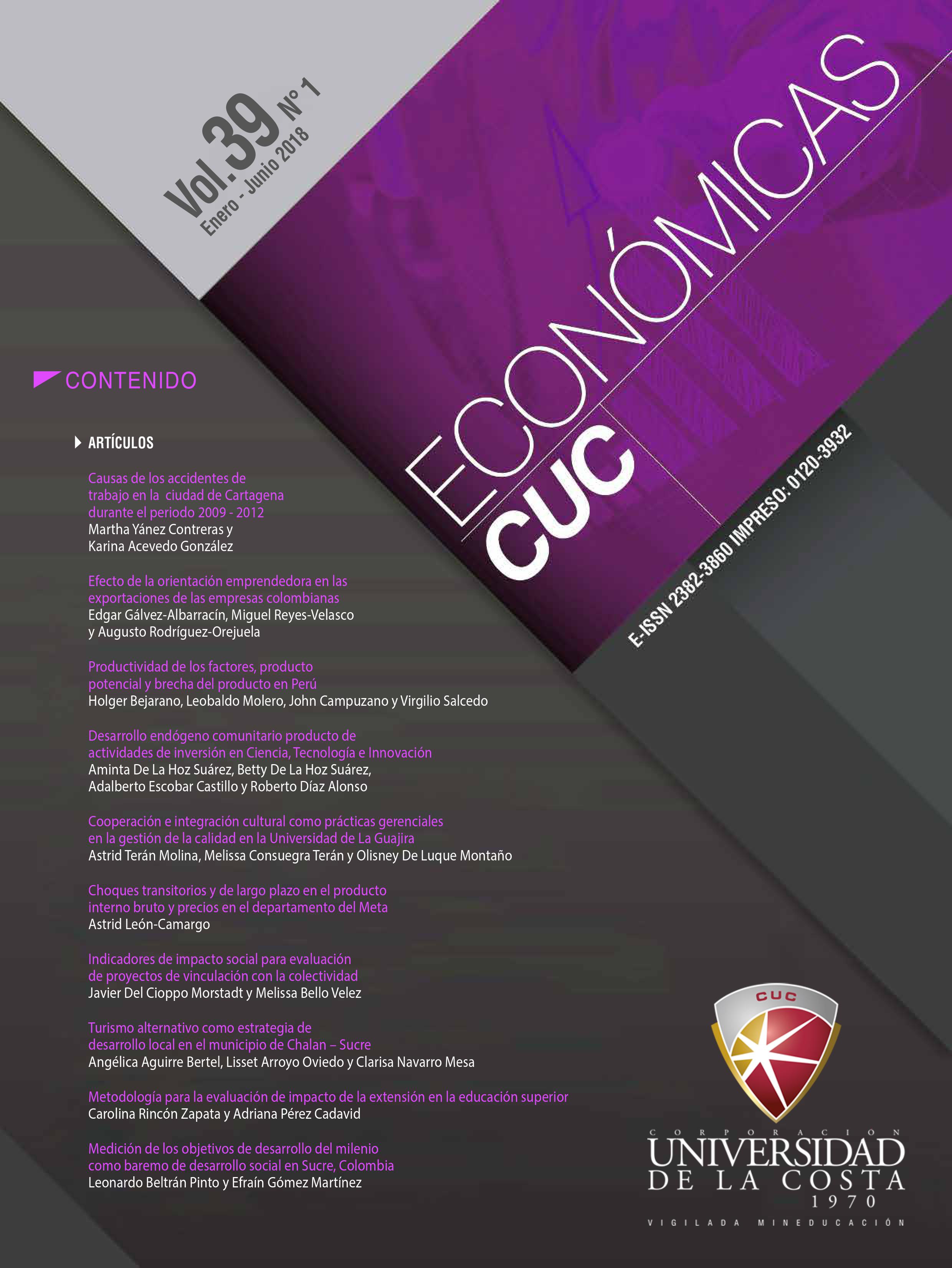Productivity of the factors, potential product and gap of the product in Peru
DOI:
https://doi.org/10.17981/econcuc.39.1.2018.03Keywords:
productivity, potential product, product gap, growth accounting.Abstract
The aim of the article was to estimate the factors' productivity, the potential product and the product gap in Peru, combining the Solow approach, a Cobb-Douglas function and the Hodrick-Prescott filter. The study is explanatory. The product elasticity was used to collect the factor shares in income and for the accounting of growth. The results suggest that the Cobb-Douglas is pertinent to represent the product in Peru, the product-capital elasticity is close to the values available in other periods, and the estimates of the potential GDP and the gap are virtually identical in both methodologies.
Downloads
References
Bartelsman, E., Haltinwanger, J., & Scarpetta, S. (2013). Cross-country differences in productivity: the role of allocation and selection. American Economic Review, Vol. 103 (1), 305-334.
Cabredo, P., & Valdivia, L. (1999). Esti-mación del PBI potencial: Perú 1950-1997. Revista Estudios Económicos, No. 5, Banco Central de la Reserva del Perú.
Carranza, E., Fernández, J., & Morón, E. (2003). Peru: Markets, government and the sources of growth. Lima: Universidad del Pacifico, Department of Economics.
Cartaya, V., Dorta, M., Pérez, J.C., & Zambrano, J.A. (2008). La brecha del producto en Venezuela: algunas opciones para su estimación. Venezuela: Banco Central de Venezuela, Serie Documentos de trabajo No. 102. Recuperado de http://200.74.197.135/upload/publicaciones/docu102.pdf
Castilleja-Vargas, L. (2018). Development challenges in Peru. Washington, D.C.: Inter-American Development Bank, Policy Brief No. IDB-PB-287, June 2018.
Céspedes, N., & Ramírez, N. (2016). Estimación de la productividad total de los factores en el Perú: enfoques primal y dual. En Céspedes, Lavado & Ramírez: Productividad en el Perú, medición, determinantes e implicancias. Lima: Universidad del Pacifico
Cobb, C.W., & Douglas, P.H. (1928). A theory of production. American Econo-mic Review, Vol. 18, 139 – 165.
De Gregorio, J. (2007). Macroeconomía: teoría y política. México: Pearson Educación.
De Long, B. (2003). Macroeconomía. Madrid: McGraw Hill.
Dornbusch, R., Fischer, S., Startz, R. (2009). Macroeconomía. México: Mc-Graw-Hill.
Dorta, M. (2006). La función de producción, el producto potencial, y la inflación en Venezuela (1950-2005). Venezuela: Banco Central de Venezuela, Serie Documentos de trabajo No. 87. Recuperado de http://www.bcv.org.ve/publicaciones/ndeg-087-la-funcion-de-produccion-el-producto-potencial-y-la-inflacion-en-venezuela
Elías, V. J. (1993). Sources of growth: A study of seven Latin American economies. San Francisco: ICSPress.
Feenstra, R.C., Inklaar, R.C., & Timmer, M.P. (2015). The next generation of the Penn World Table. American Economic Review, Vol. 105 (10), 3150-3182.
Fondo Monetario Internacional (FMI) (2013, Septiembre). ¿Qué es la brecha del producto? Finanzas y Desarrollo. Recuperado de https://www.imf.org/external/pubs/ft/fandd/spa/2013/09/pdf/basics.pdf
Gallego, F., & Johnson, C. (2001). Teorías y métodos de medición del producto de ten-dencia: una aplicación al caso de Chile. Revista Economía Chilena, 4 (2), 27-58.
Greene, W. (2002). Econometric Analysis(5th ed.). Upper Saddle River, New Jersey: Prentice Hall.
Hodrick, R., & Prescott, E. (1997[1981]). Post-war U.S. Bussines Cycles: an Empirical Investigation. The Center for Mathematical Studies in Economics and Management Sciences. Recuperado de http://www.kellogg.northwestern.edu.
Jones, Ch. (2009). Macroeconomía. Barce-lona: Antoni Bosch, editor.
Loayza, N., Fajnzylber, P., & Calderón, C. (2005). Economic growth in Latin America and the Caribbean: stylized facts, explanations, and forecasts. Washington, D.C.: The World Bank.
Miller, S. (2003). Métodos alternativos para la estimación del PBI potencial: Una aplicación para el caso de Perú. Perú: Banco Central de Reserva del Perú.
Molero, L. (2013). Análisis de la relación entre el comportamiento del desempleo y del producto interno bruto en Venezuela (período 1950-2010) (Tesis de Maestría). Universidad del Zulia, Maracaibo, Venezuela.
Molero, L. (2014). Convergencia en producto per cápita: Evidencia para Suramérica. Revista de Ciencias Sociales, Vol. XX (4), octubre-diciembre, pp. 692–705.
Molero, L. (2016). Desempeño manufacturero y producto agregado bajo el enfoque kaldoriano. Memorias del V Congreso Venezolano y VI Jornadas Nacionales de Investigación Estudiantil “Dr. Jesús Enrique Lossada”. Universidad del Zulia. Maracaibo, Venezuela. pp. 2261-2271.
Monge, C. (2012). Estimación de una función de producción para Costa Rica: 1978-2010. Costa Rica: Banco Central de Costa Rica, Documento de Trabajo No. 19-2012.
Mora, J. (2006). La productividad multifactorial y el crecimiento económico en Venezuela. Actividad Contable FA-CES, Año 9 (13), 92-104.
Niño, J. (2013). Estimación del PIB potencial y la brecha del producto en Venezuela: 1950-2012. Temas de Coyuntura, No. 68, 59-90.
Romer, D. (2006). Macroeconomía avanzada. España: Mc Graw-Hill.
Seminario, B., & Beltrán, A. (1998). Crecimiento económico en el Perú: 1896-1995. Nuevas evidencias estadísticas. Lima: Universidad del Pacífico.
Sydsæter, K., & Hammond, P.J. (1996). Matemáticas para el análisis económico. Madrid: Prentice Hall.
Solow, R. M. (1957). Technical change and the aggregate production function. The Review of Economics and Statistics, Vol. 39 (3), 312-320.
Suárez, F. (2010). Estimación de una función de producción agregada: Argentina 1975-2006. Aplicaciones al crecimiento económico. Ensayos de Po-lítica Económica, 4, 54-87.
Vega, M. (1989). Inversiones y cambio técnico en el crecimiento de la economía peruana. Revista Economía, Vol. 12 (24), 9-48.
Downloads
Published
How to Cite
Issue
Section
License
You are free to:
- Share — copy and redistribute the material in any medium or format
- The licensor cannot revoke these freedoms as long as you follow the license terms.
Under the following terms:
- Attribution — You must give appropriate credit , provide a link to the license, and indicate if changes were made . You may do so in any reasonable manner, but not in any way that suggests the licensor endorses you or your use.
- NonCommercial — You may not use the material for commercial purposes .
- NoDerivatives — If you remix, transform, or build upon the material, you may not distribute the modified material.
- No additional restrictions — You may not apply legal terms or technological measures that legally restrict others from doing anything the license permits.


 English
English
 Español (España)
Español (España)














